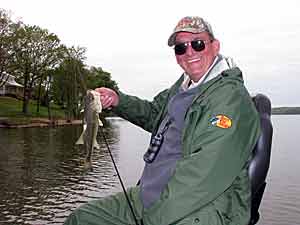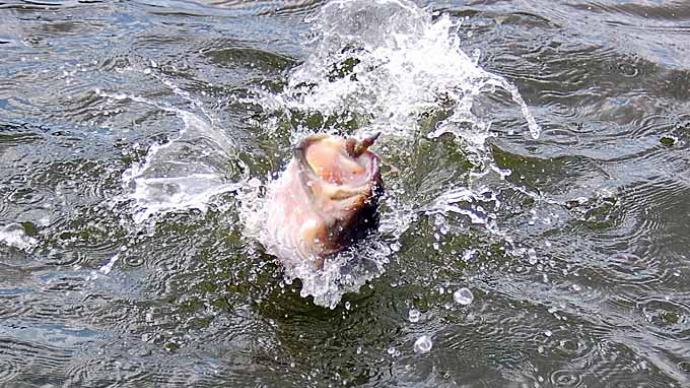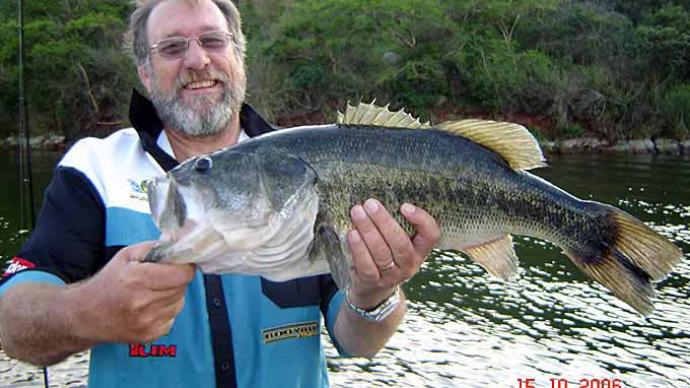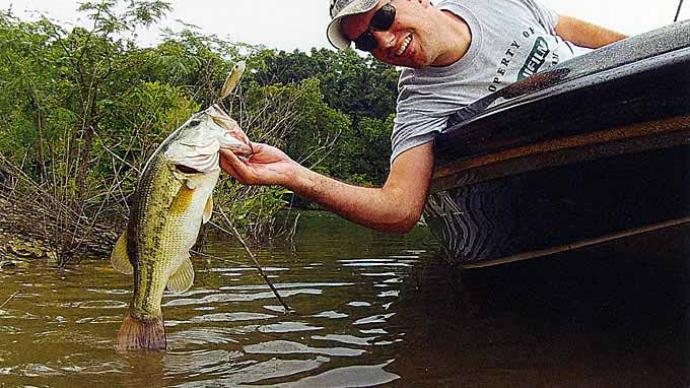
"I don't see what you bass fishermen need with all them rods. I'm doing all I can to fish with two," said the semi-pro crappie fisherman. He was tied up beside me as I waited for my partner to park the truck and trailer before we left to pre-fish that morning.
I can fully understand why six or seven rods, all rigged differently, laying on the deck of a bass boat, might seem extravagant to a fisherman who only uses one rig all day. But as bass fishermen, we know there are at least that many rigs that differ from each other, and every one has its application. I hate to take the time to retie after I break one off, much less settle for one rod, one reel, one line size, and all the knots needed to fish every situation encountered on a single fishing day.
Every angler should have at least four rigs ready for every trip, regardless of where you're fishing or when. These are the ever-popular Texas, Carolina, split-shot, and drop-shot rigs.
The Texas Rig
Quite possibly, everyone reading this cut their teeth fishing plastics using a Texas rig. I remember in the mid-to-late '70s, right after Creme brought out the first "rubber worms," as we called them then. It didn't take long for someone to figure out how to hide the hook in the worm to make it weedless. Until the late 80's, Texas rigs were "the only way" to fish a worm. It consisted of a bullet weight with a hole through it and a hook. We all used a 20- or 25-pound test line on a "pool cue" with eyes - and that was how we fished a Texas rig.
That was then but now is now. A Texas rig now starts with a 7 to 7 1/2-foot quality rod that is very sensitive in heavy power, a slow-geared reel, as light pound test line as is possible for the water you are fishing, and a sinker.
Tungsten sinkers are heavier than lead, noticeably smaller, and not nearly as hard on the environment. They have a tapered head and come through cover easily. Although they cost more than lead sinkers, their prices continue to come down.
But the most advanced part of a Texas rig these days are the new hooks that are available. Owner Hooks constantly adds new and better hooks for every type of fishing to their product line. Anglers haven't missed the point, either. If I'm using a lizard or the new creature baits everyone has now, I like their "J" Hook. It has an extra wide bend and a worm-holding Z-lock shoulder bend at the eye. It is perfect for these baits and all larger plastics. I like their offset shank wide gap for smaller baits and small worms and use it for most smaller applications. Their cutting point is the sharpest and won't let the worm bunch up, or the fish get off.
As for tying a real Texas rig, simply thread the line through the sinker with the tapered end forward. Then, tie the hook on the line using a Palomar or a Trilene knot. Run the hook's point through the top of the worm and back out about 1/4 to 3/8 of an inch down the worm. Turn the hook and run the point back into the worm without exposing the hook point, and be sure to keep the bait as straight as possible.
The Carolina Rig
To an old striper guide friend of mine on Texoma, this used to be called a chicken liver rig. He still won't throw one, and if you think similarly, you are so far behind the power curve that you can't even see our dust. In certain situations, nothing works as well as a Carolina rig. In years past, this was a heavy 1/2-ounce egg-shaped sinker, a glass bead, a swivel, and a hook.
That was then. Most people these days start with a 7 1/2-foot medium-heavy, fast-action, highly sensitive, quality rod for added distance on the cast and to take up the slack on a sweeping hook-set. It's generally teamed with a 6.1:1 retrieve ratio reel. A smaller line size doesn't mean as much because many people use a lighter-weight fluorocarbon leader material.
This rig allows a sinker to be attached to your line ahead of a bead and swivel, then a leader of a specified length, onto which the hook and your plastic lure are rigged. It allows the fish to pick up the lure and move it the distance of the leader length without feeling the resistance of the weight. One of the pros I listened to once told us, "The colder the water, the shorter the leader length," this holds true. But you could use a Texas rig if you get shorter than eight inches. So I usually fish about an 18-inch leader except when fishing grass, and I have fished them as long as four feet in certain situations.
The long-term problem with the old Carolina rigs was fishing standing or downed timber or rocks. You couldn't put that damn egg sinker through it. The second thing was that you couldn't feel the bite when a fish picked up the bait, and it was hard to get a good hookset that would hold the fish.
Again, technology has fixed two of these three problems. The first is the sinker. Lindy Little Joe has brought out a sinker called the Lindy No-Snag. It is long and slender and has a 20-degree bend about halfway down. It is available with a rattle or without, comes in 1/8- through 1-ounce, and will come through snags better than anything you've ever tied on. They come with a black coating, which the factory says is a vinyl-like substance. My point here is that I have used this same sinker for so long that most of the coating is gone, but I've still got it. It comes through rocks and tree limbs like nothing else.
The other problem with Carolina rigs that has been fixed is the hook-set problem. Owner has brought out a hook called Rig-N-Hooks. They are engineered for Carolina rigs as well as split-shot rigs. They ride with the point upright. They have a huge wide bite on a short shank and also have a cutting point. They are available from a tiny size to 5/0. I've used the #1 and the 1/0 for Carolina-rigged 4-inch finesse worms and had no problems hooking or landing fish. The third and most significant problem with this rig is feeling the bite. This is hard to overcome. I suggest using a super-sensitive rod and paying close attention to how the rig feels. If the "feel" changes in any way at any point, set the hook.
The Split Shot
A split shot rig consists of a hook tied directly on the end of your line and a small 3/ 16-ounce or smaller split shot pinched on the line. This rig is used in fairly shallow water. It is excellent for sight fishing and to pitch at and around boat docks or shallow cover. The magic is that its light weight offers little or no resistance to the fish when picked up. The problems with this rig were that it was hard to pull an odd-shaped split shot through the cover, and the weight pinched on the line created the second problem. It will not slide down the line if you pinch it too hard. The monofilament is weakened at that point.
That was then. Now, Phenix has developed a weight called the Vengeance Finesse Slider weight. Their narrow cylindrical shape allows them to slip through rocks and other underwater obstructions with fewer hangups, and they are easy to peg onto your line with a bobber stopper if you choose. They’re available in a range of sizes. I place one about 12 inches above the hook.
I like to use a 7-foot medium power extra-fast tip rod for split shotting. The medium pwer is forgiving enough to keep the usually small hook stuck when a fish jumps or pulls, and the tip makes for longer casts with this lightweight rig. Either of the Owner hooks mentioned earlier works well on this rig.
The Drop Shot
This is one of the hottest rigs to hit the bass fishing industry. Most touring pros fish it; if you haven't tried it, you should. It has a hook tied from 10 inches to four feet above a sinker. It is most productive in early spring when water temperatures are below 55 degrees, and the fish are ganged up in deep water. This situation happens again in late summer when the fish are in their deep-water territories and don't move shallower than they have to for foraging purposes.
The most popular baits for this rig are the small, hand-poured 2- to 4-inch baits. Most plastics manufacturers have brought out a line of downsized worms, craws, or creature baits to use this system. It is straightforward to tie.
Again, Owner Hooks has developed a new hook, especially for this system. It is called the Down Shot and is an offset hook. It is designed to ride perfectly horizontally when tied to a line to be fished straight up and down. Use your favorite knot, but pull the tag end up over and back through the hook's eye. Leave this tag end as long as you want your bait to be off the bottom.
Tackle Warehouse sells special drop shot sinkers designed to be fished on this rig. They have a wire clip on top that you run your line through and pull it up tight in this wire clip. It is designed to pull free if it hangs up without losing your fish or hook. Most people are fishing this rig on a soft-tip spinning rod with line less than 8-pound test. I'm fishing mine on a 7-foot medium-fast tip using 8-pound P-Line. I had to make myself put everything else in the box and learn to fish it, but for deep-water fishing, it can't be beaten.
Suppose you know how to rig and understand the separate applications of these four popular methods. In that case, you have covered the spectrum of bass fishing for soft plastics and should have an excellent arsenal on every trip to any lake anywhere in the US.
The tackle industry has dramatically improved our odds at the game, but becoming adept with any of these rigs and products is up to you.
Till next time, remember you create your own luck.
If you know how to rig and understand the separate applications of these four popular methods then you have covered the spectrum of bass fishing for soft plastics and should have an excellent arsenal on every trip to any lake anywhere in the US.
BassResource may receive a portion of revenues if you make a purchase using a link above.
The tackle industry has done a great deal to improve our odds at the game, but becoming adept with any of these rigs and products is up to you.
Till next time, remember you create your own luck.




